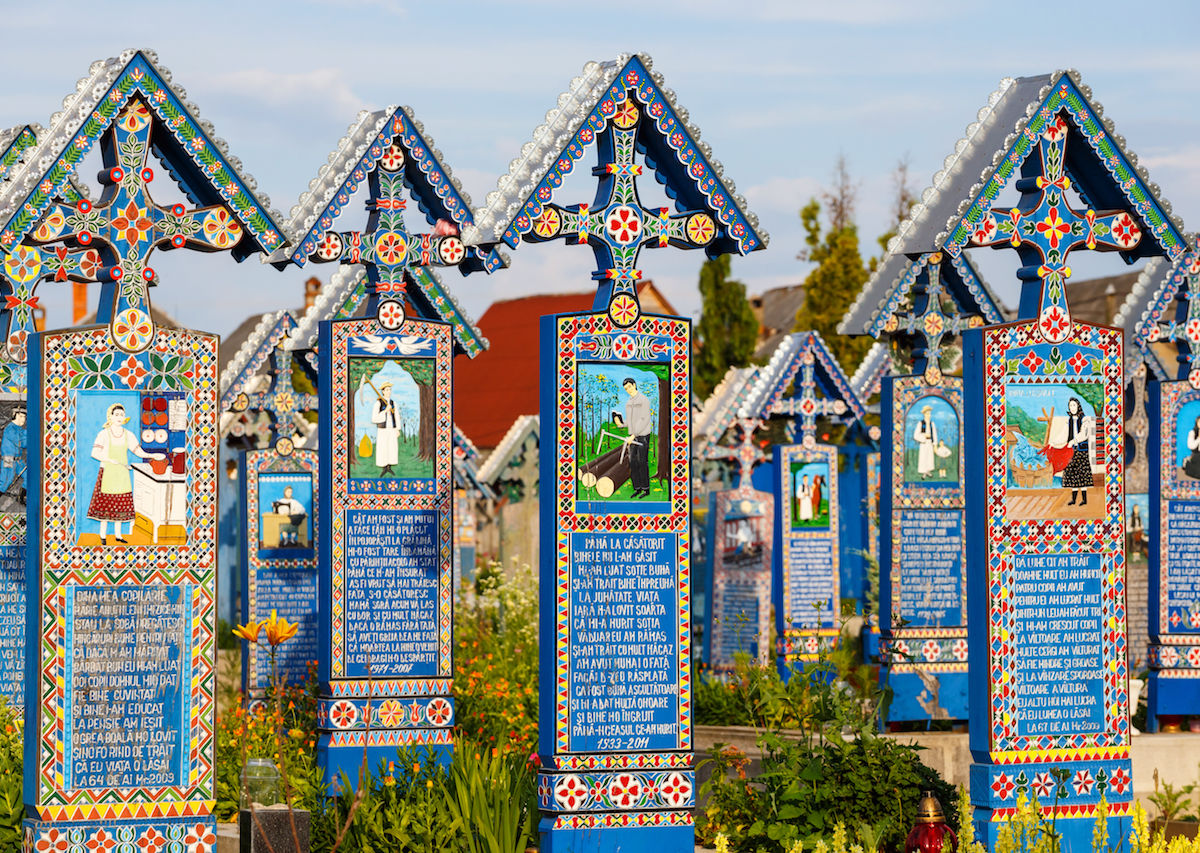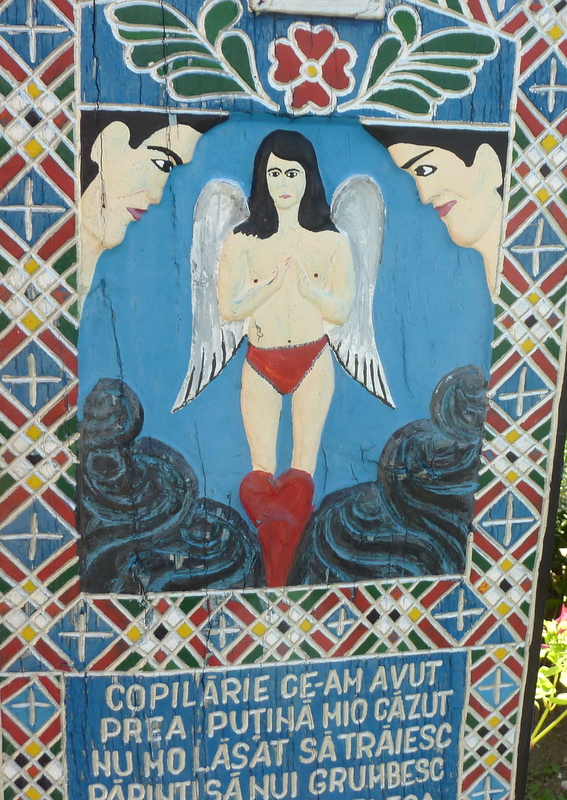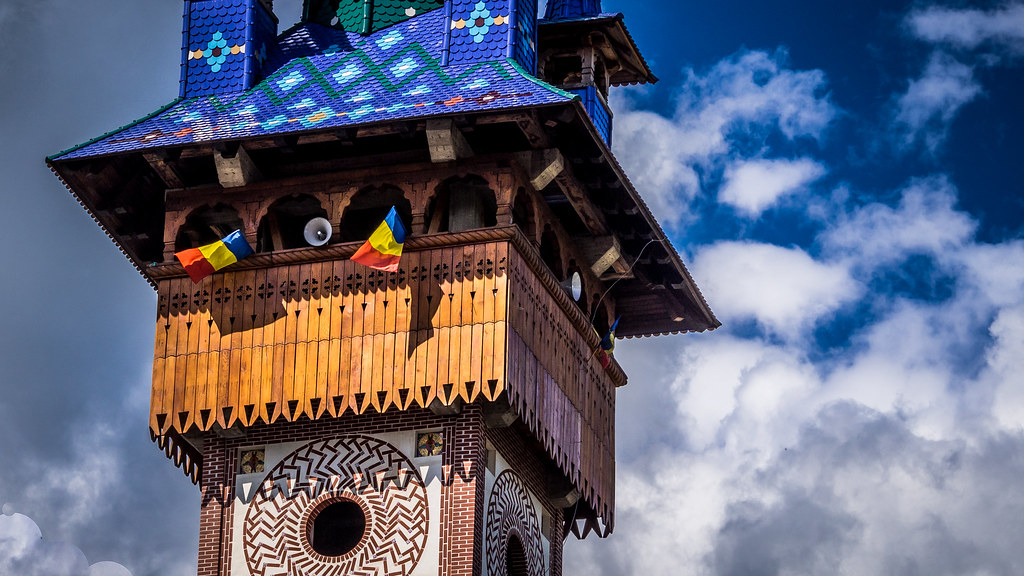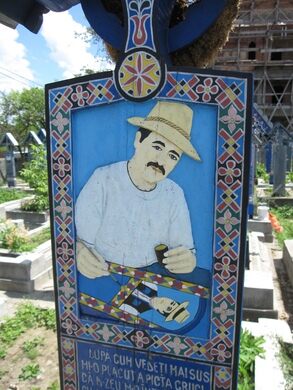Happy Cemetery (Merry Cemetery), Sapanta. Both the church and surrounding cemetery must be seen to be believed. All the grave markers are fantastic wood painted creations. Topped with a gable roof, each is a narrow rectangle with colourful geometric borders, a long inscription with dates (I wish I could read Romanian to understand what they said) and best of all an intricate folk carving about the deceased – the men usually their occupation (farmer, logger, butcher, military, policemen) and the women, their crafts or daily routine (cooking, knitting, spinning, working at a loom). Most have the reverse side painted similarly. The wood slabs are attached to a cement rectangle with metal cleats. There are hundreds, maybe thousands.



The church is equally fantastic with high stone walls topped by intricate brick surrounding mosaics of saints around the entire building. The white cement buttresses also have mosaics – they use ceramic images for some and tiles. The huge tower terminates in a spike of spire and a lovely cross. The roof of the spire and church is green with multi-coloured tiles. Wow.
The interior of the church was plain white cement but was in the process of being plastered and painted. The apse was full of scaffolding and the back of the apse had been finished with typical frescoes. About 6 men from Bucharest were painting the dome of the apse and side walls. The plan was to paint the entire church – taking two years. The shallow dome in the centre of the nave was a rich mosaic of Mary surrounded by 8 angels. I even watched the guy make the plaster.5 Lei


From the write up at the entrance of the church: On the banks of the Tisa River and dominated by the Carpathian Peaks, Sapanta is a town of 3500. The people are attached to lands, independent spirit and strict respect for customs and traditions, especially the Orthodox religion. At Sunday service, the people wear traditional costumes and forget their quarrels and misunderstandings.
The forest was the basis of the economy and wood is everywhere in the architecture, floral motifs and sun and moon. The Romanian peasant has never been afraid of death, a gateway to eternal rest, a natural event accepted as fate.
The cemetery is the centre of the community with 800 folk art monuments, a true and complex outdoor museum. The cemetery is the lifetime work of the renowned painter, folk sculptor and poet Ion Stan Pâtros and was continued by Dimitru Pop. The crosses are carved from oak, painted in “Sapanta” blue with an epitaph written in short verses of simple lyrics and full of spirit and grace. It includes the name and and what was essential in their life, their thoughts, concerns and feelings, state of mind, virtues, vices, some with a touch of humour. Many relate dramas and tragedies – war, oppression or the death of a loved one.
The painting shows them in important moments of their life. It is an attempt to look at life in a different way. Death is not first but rather the rush of life.
Meta
Archives
- May 2024
- April 2024
- March 2024
- February 2024
- January 2024
- December 2023
- November 2023
- October 2023
- September 2023
- August 2023
- July 2023
- June 2023
- May 2023
- April 2023
- March 2023
- February 2023
- January 2023
- December 2022
- November 2022
- October 2022
- September 2022
- August 2022
- July 2022
- June 2022
- May 2022
- April 2022
- March 2022
- February 2022
- January 2022
- December 2021
- November 2021
- October 2021
- September 2021
- August 2021
- July 2021
- June 2021
- May 2021
- April 2021
- March 2021
- February 2021
- January 2021
- December 2020
- November 2020
- October 2020
- September 2020
- August 2020
- July 2020
- June 2020
- May 2020
- April 2020
- March 2020
- February 2020
- January 2020
- December 2019
- November 2019
- October 2019
- September 2019
- August 2019
- July 2019
- June 2019
- May 2019
- April 2019
- March 2019
- February 2019
- January 2019
- December 2018
- November 2018
- October 2018
- September 2018
- August 2018
- July 2018
- June 2018
- May 2018
- April 2018
- March 2018
- February 2018
- January 2018
- December 2017
- November 2017
- October 2017
- September 2017
- August 2017
- July 2017
- June 2017
- May 2017
- April 2017
- March 2017
- February 2017
- January 2017
- December 2016
- November 2016
- October 2016
- September 2016
- August 2016
- July 2016
- June 2016
- May 2016
- April 2016
- March 2016
- February 2016
- January 2016
- December 2015
- November 2015
- October 2015
- September 2015
- August 2015
- July 2015
- June 2015
- May 2015
- April 2015
- March 2015
- February 2015
- January 2015
- December 2014
- November 2014
- October 2014
- September 2014
- August 2014
- July 2014
- April 2014
- March 2014
- February 2014
- January 2014
- December 2013
- November 2013
- October 2013
- September 2013
- August 2013
- July 2013
- May 2013
- April 2013
- March 2013
- February 2013
- January 2013
- December 2012
- November 2012
- October 2012
- June 2012
